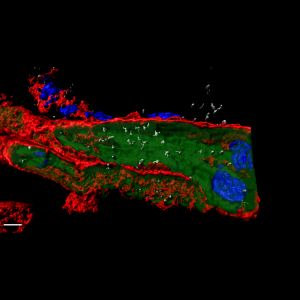Aunque el virus de la gripe causa fundamentalmente infecciones respiratorias, también puede producir un daño fuera del sistema respiratorio, con complicaciones como el infarto de miocardio. En la pandemia de 2009 se observó que había complicaciones cardiacas en casi el 5% de los pacientes, de los cuales más del 40% requirieron el ingreso en unidades de cuidados intensivos. Sin embargo, no se han realizado muchos estudios que expliquen cuál es el mecanismo molecular detrás de las alteraciones a nivel cardíaco y cómo el virus puede llegar a afectar al corazón.
A partir de la identificación de dos cepas del virus de la gripe pandémica de 2009 con distinta patogenicidad en pacientes, los científicos han podido analizar diferencias en el curso de la infección en modelos de ratón. Los investigadores observaron que los ratones infectados con el virus más patogénico presentaban daño cardiaco directo y fallecían por muerte prematura con síntomas parecidos a pacientes con enfermedad cardiaca aguda y gripe pandémica.
Ana Falcón investigadora responsable del estudio y perteneciente al grupo de Amelia Nieto en el Centro Nacional de Biotecnología (CNB-CSIC) y CIBERES, destaca: “Hemos encontrado infección de las células de Purkinje, principales responsables de transmitir el impuso eléctrico en el corazón, y una inflamación cardiaca temprana, especialmente en la infección con el virus más patogénico”.
El primer co-autor del trabajo, David Filgueiras Rama, investigador del CNIC, el Hospital Clínico San Carlos y el CIBERCV, recalca: “La infección y replicación del virus en el corazón produce un fallo en la transmisión del impulso eléctrico cardiaco, que puede derivar en muerte prematura”. Como hallazgo relevante, los investigadores han demostrado que la cantidad de virus en el tejido cardíaco no tenía una relación directa con la cantidad de virus en el pulmón, lo cual, puntualiza Filgueiras Rama, “significa que el virus es capaz de causar daño cardíaco incluso con daño pulmonar menor”.
Detección temprana
A nivel molecular, los resultados encontrados por Falcón, Nieto y su equipo en células musculares cardíacas derivadas de células humanas pluripotentes indican que el virus más patogénico permanece más tiempo en el corazón y produce alteraciones, como la modificación de los canales iónicos que son responsables de la transmisión del impulso eléctrico cardiaco, lo que apoya la muerte prematura encontrada en estos animales. También destacan la relevancia de la detección temprana del virus de la gripe en casos clínicos con enfermedad cardíaca aguda durante los brotes de gripe, que permitiría un diagnóstico y tratamiento precoz de estos pacientes.
Este trabajo multidisciplinar se ha realizado con la colaboración de investigadores del Centro de Investigación Biomédica en Red de las áreas de Enfermedades Respiratorias (CIBERES), Cardiovasculares (CIBERCV) y Salud Mental (CIBERSAM), CNB-CSIC, CNIC, Hospital Clínico San Carlos, y las Universidades de Michigan y South Florida en Estados Unidos.
Más información
Filgueiras-Rama, J. Vasilijevic, J. Jalife, S. Noujaim, J.M. Alfonso, J.A. Nicolas-Avila, C. Gutierrez, N. Zamarreño, A. Hidalgo, A. Bernabé, P. Cop, D. Ponce-Balbuena, G. Guerrero-Serna, D. Calle, M. Desco, J. Ruiz-Cabello, A. Nieto, A. Falcón. Human Influenza A virus causes myocardial and cardiac-specific conduction system infection associated with early inflammation and premature death. Cardiovascular Research ;28 April, 2020. DOI: 10.1093/cvr/cvaa117






